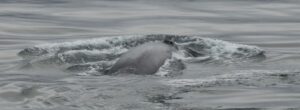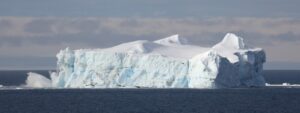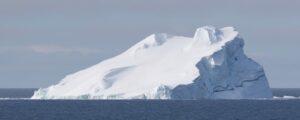By Peter Ryan, onboard scientist, expert in general ornithology, seabird-fishery interactions, evolutionary ecology, marine debris, solid waste management, biology of oceanic islands.
Leg 2, Scott to Mount Siple
Blue Whale fever struck the ship after we left Scott Island on the afternoon of 6 February. Instead of taking the direct route to Peter the 1st, we headed southeast towards a known concentration of Antarctic Blue Whales. The drawback was that we were only going to reach the area towards midnight. Undaunted, large numbers of people not normally seen on deck turned out, imploring Josh to find them a Blue Whale. Unfortunately, none obliged. 7 February dawned calm and mostly clear, and shortly after 9h00, two Blue Whales swam past, conveniently travelling with a couple of Fin Whales for comparison. Over the rest of the day we had a few more distant Blues among a plethora of mainly Hump-backed and Minke Whales. Birds were more of the same – small numbers of Mottled Petrels and Antarctic Prions, with occasional large flocks of Short-tailed Shearwaters.
8 February we continued east-southeast on the shortest route to Peter the 1st, crossing 70°S early in the morning. Despite being around 200 miles south of Mertz, the sea was largely ice free, and we sped along in calm seas. We finally lost the shearwaters, which were replaced by Antarctic Petrels, mainly roosting on the icebergs in the area. Whales were scarce compared to the previous day. 9 February was a replay of the 8th, but with even fewer birds and whales. The day was mostly enlivened by rumours that Peter the 1st was beset by sea ice and we might visit the Sipel Island area of Marie Byrd Land instead.

10 February dawned calm and so misty that even the birders gave up transects. However, the mist lifted around 7h00, and we had one of our best transit days on the trip to date. It started off with a very obliging pair of Blue Whales right next to the ship just after 8h30, and we were entertained with an endless variety of icebergs throughout the day, including a ‘tipping berg’ that rocked back and forth through about 40° with a period of more than a minute, sending off cascades of water each time the left side emerged. Snow Petrels were the commonest bird, and we started to encounter small groups of juvenile Adelie Penguins as we continued past the intended turn point at 72°S. More than an hour before the PI meeting was held we could see the imposing slopes of Mount Siple ahead, and it was clear that the decision had been made to head there to take advantage of the lovely calm weather and relatively ice-free seas. As we steamed slowly closer and closer we enjoyed large numbers of Minke Whales, as well as the occasional Emperor Penguin among the Adelies, and some Weddell Seals as we neared the coast.
Once again no litter or kelp was seen, but several jellyfish and dead birds (2 Snow Petrels and 2 Adelie Penguins) drifted past.
The list for the 1090 km of transects from Scott to Mount Siple was:
| Antarctic Petrel | 310 | Short-tailed Shearwater | 270 |
| Snow Petrel | 200 | Mottled Petrel | 137 |
| Adelie Penguin | 77 | Antarctic Prion | 34 |
| Cape (Pintado) Petrel | 19 | Blue Petrel | 15 |
| Arctic Tern | 14 | Emperor Penguin | 4 |
| Light-mantled Albatross | 3 | Southern Giant Petrel | 3 |
| Wilson’s Storm Petrel | 3 | South Polar Skua | 2 |
| Antarctic Minke Whale | 70 | Hump-backed Whale | 57 |
| Crabeater Seal | 12 | Antarctic Blue Whale | 6 |
| Fin Whale | 5 | Weddell Seal | 3 |
| Sthn Bottlenosed Whale? | 3 | Unidentified whales… | 10 |
| Antarctic Fulmar | 1 |



